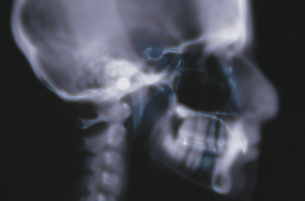Module 1
1. Module 1
1.11. Page 6
Module 1—Momentum and Impulse
Protecting Your Head

© Jim Wehje/Photodisc/Getty Images
The human skull is a thin layer of bone encasing the brain.
If you drop an expensive MP3 player onto a cement sidewalk, you might be disappointed if it no longer works, but at least you can have it repaired or replaced. There are many more on store shelves and the newer models often come with improved features. If you hit your head on a cement sidewalk, the long-term consequences could be much more serious. Although medical science has learned a lot about the workings of the brain, only so much damage can be repaired, and, unlike your MP3 player, an off-the-shelf replacement for your brain is out of the question.
People who are exposed to hazards that could lead to head injuries and possible brain damage take protective measures while at work or at play. In short, they wear helmets.

(left to right): Adam Crowley/Photodisc/Getty Images; Eyewire/Getty Images; Photodisc/Getty Images; Eyewire/Getty Images
Here are a few examples of how people protect their heads at work and at play.
Which activities do you participate in that require a helmet? Some possibilities include riding all-terrain vehicles (ATVs), playing hockey, downhill skiing, snowboarding, and inline skating. The activity that is probably on most lists is cycling. Since most people learn to ride a bicycle at a young age and can continue that activity into adulthood, the use of bicycle helmets has received public attention across Canada, including legislation for mandatory use.
Many people have strong opinions regarding the mandatory use of bicycle helmets. At the heart of the issue is this question: “What evidence is available to support the idea that the use of bicycle helmets significantly reduces head injuries among cyclists?” You will have an opportunity to answer this question in the next activity.
 Module 1: Lesson 2 Assignment
Module 1: Lesson 2 Assignment
Remember to submit the answers to D 2 to your teacher as part of your Module 1: Lesson 2 Assignment.
 Discuss
Discuss
In this activity you will use the Internet as a research tool.
D 1. What evidence is available to support the idea that the use of bicycle helmets significantly reduces head injuries among cyclists? Describe the overall trends in the data you collected.
D 2. Post your findings to the discussion area, and compare your findings with those of other students. How do their findings differ from yours? Are the arguments made to support these views consistent with the information you researched? Did other students find additional information unknown to you? Has your opinion of bicycle helmets changed since you started? Explain.
Principles involved: momentum |
||||
Criteria |
Level 1 (Below Standard) |
Level 2 (Approaching Standard) |
Level 3 (Standard) |
Level 4 (Above Standard) |
Knowledge |
||||
Demonstrates understanding of the situation, physics principles and technology, and their connections. |
Demonstrates a vague and sometimes incorrect understanding of the physics principles involved. Obvious irrelevant or missing information. |
Demonstrates a basic understanding of the physics principles involved. May exhibit minor mistakes or vague information or application to the situation. |
Demonstrates a good understanding of the physics principles involved and applies them properly to the given situation. All necessary information is given. |
Demonstrates a superior understanding of the physics principles involved and their application to the situation. All applications are considered in detail. |
Reflection |
||||
The post shows reflection on one’s own and other students’ work. Contributes to the group discussion. |
Does not make an effort to participate. Seems indifferent to discussion. |
Occasionally makes meaningful reflections on the group’s efforts or discussions. Marginal effort is shown to become involved with the group or discussion. |
Frequently makes meaningful reflections on the group’s efforts and presents relevant viewpoints for consideration by the group. Interacts freely with group members. |
Regularly attempts to motivate the group discussion and delve deeper into concepts. Interacts freely and encourages all group members. |
Content and presentation of discussion summary |
||||
The information is logically arranged in a clear and concise manner. |
The information is poorly organized with many concepts implied. Irrelevant or rambling sentences make reading difficult. |
The information is somewhat organized with implied concepts. Excessive words or awkward sentences are used, which hinder reading. |
The information is well-organized and logically arranged. All concepts are explicitly explained. There are a few awkward but understandable sentences. |
The information is well- organized and very easy to understand. Well-worded sentences make reading pleasurable. |
 Reflect on the Big Picture
Reflect on the Big Picture
Now that you understand impulse and how the product of net force and time will impact a situation, you understand how a helmet can prevent injuries when people are participating in sports and recreational activities. Using the concept of impulse, explain how a helmet prevents injuries when somebody participates in the sport or recreational activity of your choice. Save your explanation in your course folder.